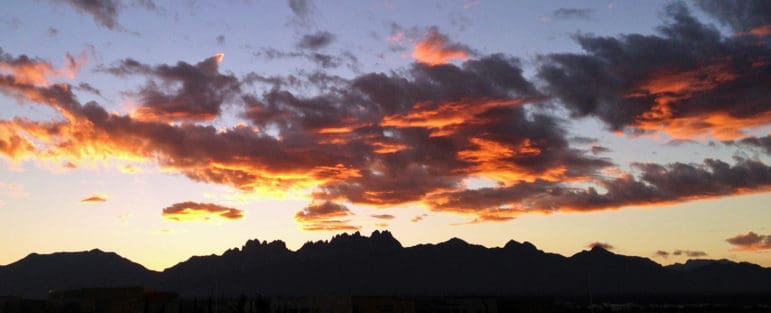
Heath Haussamen / NMPolitics.net
The Organ Mountains near Las Cruces at sunrise. The mountains are part of a national monument that is subject to a review President Donald Trump ordered Wednesday.
U.S. President Donald Trump on Wednesday signed an executive order directing the interior secretary to review certain national monuments, including two in New Mexico, which raises questions about the future of those monuments.
“The Antiquities Act does not give the federal government unlimited power to lock up millions of acres of land and water, and it’s time we end this abusive practice,” Trump said when he signed the order.
What could come from the review isn’t clear, though a legal battle is possible. Two monuments former President Barack Obama created in New Mexico — the Organ Mountains-Desert Peaks National Monument around Las Cruces and the Rio Grande del Norte National Monument near Taos — are subject to the review.
Obama designated the monuments using the 1906 Antiquities Act, which, according to The New York Times, was intended “to prevent looting of Indian artifacts from archaeological sites.” Since then, presidents have used the act primarily “to turn public land into national monuments protected forever from commercial development or future mineral exploitation,” the newspaper wrote.
Will Trump try to revoke some monument designations? It’s not clear. According to The Times, “Most legal scholars and historians agree that the Antiquities Act does not give the president the authority to revoke previous national monument designations, but a president can change the boundaries of a national monument.”
The Christian Science Monitor had a different take, pointing out that some presidents have reduced the size of monuments, “But, legal scholars note, none of those reductions were ever challenged in court, so there is no legal opinion on whether presidents actually had the power to make them. And all of them occurred prior to the Federal Land Policy and Management Act of 1976, which some experts believe more explicitly limits presidential powers to revoke or change monuments.”
Trump’s potential ability to change the boundaries could be significant for the monument around Las Cruces. The area’s congressman, U.S. Rep. Steve Pearce, a Republican, opposed creation of the approximately 500,000-acre monument in 2011 but has proposed protection for a smaller section of land that includes the Organ Mountain’s peaks.
Pearce has been clear that he doesn’t believe the land at the base of the Organ Mountains should be in the monument.
In a statement, Pearce criticized the Obama and Bush administrations for “creating expansive national monuments that blatantly disregarded input from local communities and governments that are directly affected by these designations.”
“We all share the common goal of preserving the beauty of our lands for generations to come, but responsible conservation efforts must consider input from surrounding communities and the local economies that are affected,” Pearce said. “I support today’s action to review our national monument designations and look forward to working with the administration to ensure that the beauty of New Mexico is preserved.”
Support for protecting the land around Las Cruces, including the Organ Mountains, in the years leading up to Obama’s monument designation was widespread but not universal. Since the monument’s creation, the federal government has improved roads and access to recreation areas around Las Cruces and put up historical signs.
Meanwhile, in Northern New Mexico, U.S. Rep. Ben Ray Luján, a Democrat, pledged to fight to preserve the monument near Taos.
“The decision to designate the Río Grande del Norte a national monument was strongly supported by the local community and members of the New Mexico congressional delegation,” Luján said.
U.S. Sen. Tom Udall, D-N.M, spoke about the economic impacts of the monuments and pledged to fight as well — in court if necessary.
“I do not believe that President Trump has the legal authority to rescind a national monument designation, and if he attempts to do so, I will fight him every step of the way,” Udall said.
“If Secretary [Ryan] Zinke decides to review Organ Mountains Desert Peaks and Rio Grande del Norte, he will find strong, vibrant monuments that are driving new recreation and tourism-oriented businesses and jobs and that are the pride of the surrounding communities,” Udall said.
Trump’s order directs Zinke to consider the decision-making process that went into creating the monuments.
“Monument designations that result from a lack of public outreach and proper coordination with State, tribal, and local officials and other relevant stakeholders may also create barriers to achieving energy independence, restrict public access to and use of Federal lands, burden State, tribal, and local governments, and otherwise curtail economic growth,” the order states.
U.S. Sen. Martin Heinrich, D-N.M., warned Trump against attempting to undo the monuments.
“If this sweeping review is an excuse to cut out the public and scale back protections, I think this president is going to find a very resistant public,’” Heinrich was quoted by the Albuquerque Journal as saying.
This article has been updated with information from the Christian Science Monitor.